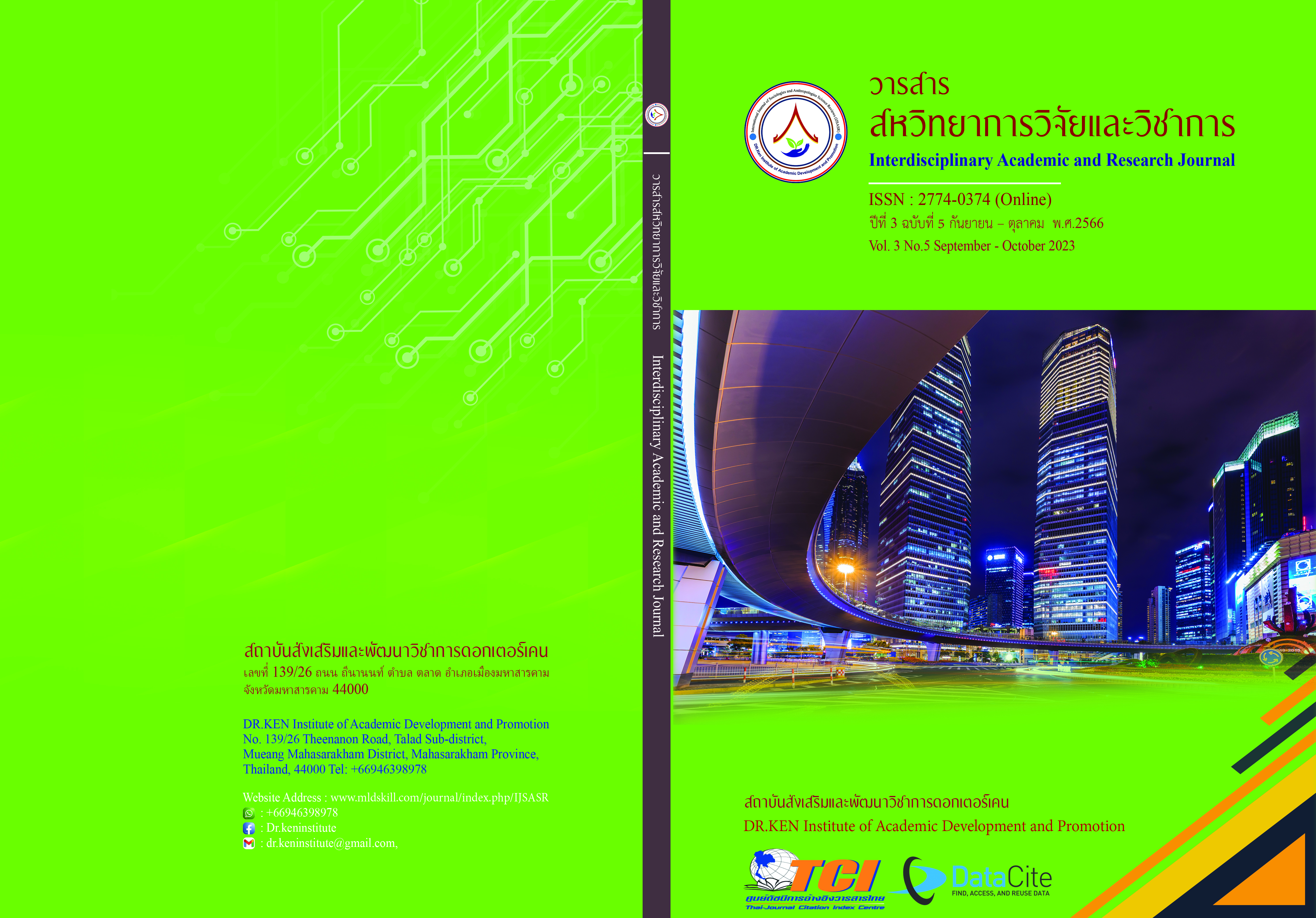The Model for Administration of Information and Communication Technology in Digital Age for School under Samut Prakan Primary Educational Service Area Office 1
DOI:
https://doi.org/10.14456/iarj.2023.277Keywords:
Model; , Management; , Information Technology; , CommunicationAbstract
The important goal of education management is to have an education system that responds to and keeps up with changes in the dynamic world and changing contexts. All learners, all target groups, receive educational services with equal quality standards. Therefore, the management of information technology and communication within educational institutions will affect the development of learning management between teachers and learners to be appropriate and quality. This will be an important mechanism for developing the quality of learners to have knowledge, skills, and desirable characteristics. The purpose of this research is to develop a management model for information and communication technology in the digital age for schools under the Samut Prakan Primary Educational Service Area Office 1, by conducting 3 steps: Step 1 studying the problem and needs assessment on the management of information technology and communications in school under the Samut Prakan Primary Educational Service Area Office 1 from documents and questionnaire with 20 school directors. Step 2 Create and examine the model, by using the drafted data, and evaluating the accuracy and suitability of the model through expert-based based seminars with focus group discussions. Step 3 evaluates the model to verify the possibilities and benefits with questionnaires from 20 experts who are the school stakeholders. The research results revealed that the model for the administration of information and communication technology in the digital age for schools under the Samut Prakan Primary Educational Service Area Office 1 consists of 3 main components, which are 1)Information and communication technology framework with 5 sub-components: information and communication technology infrastructure; information and data collection work; development; review and analyze data; and apply information and communication technology in education. 2) Information and communication technology management operations with 6 steps: planning; organizing; acting; controlling, follow-up and evaluating; improving; and integrating. 3) Factors affecting the use of information and communication technology with 3 factors: information and communication technology strategy; the role of supporting personnel; and the teacher competency development process. From the results of the evaluation of the developed model, it was found that the possibilities and benefits are at a high level.
References
จินตนา ศักดิ์ภู่อร่าม. (2545). การนำเสนอรูปแบบการบริหารโรงเรียนในกำกับของรัฐ สำหรับประเทศไทย. กรุงเทพฯ: จุฬาลงกรณ์มหาวิทยาลัย.
ชฎาภรณ์ สงวนแก้ว. (2549). การศึกษาการบริหารเทคโนโลยีสารสนเทศและการสื่อสารของโรงเรียนต้นแบบการพัฒนาการใช้ไอซีทีเพื่อการเรียนรู้. วิทยานิพนธ์ปริญญาครุศาสตรมหาบัณฑิต สาขาวิชาการบริหารการศึกษา. กรุงเทพฯ: บัณฑิตวิทยาลัย มหาวิทยาลัยราชภัฏจันทรเกษม.
เด่นชัย โพธิ์สว่าง. (2550). สภาพการดำเนินงานและความต้องการใช้เทคโนโลยีสารสนเทศและการศึกษาในสถานศึกษาขั้นพื้นฐาน สังกัดสำนักงานเขตพื้นที่การศึกษาหนองคาย เขต 3. วิทยานิพนธ์ปริญญาครุศาสตรมหาบัณฑิต สาขาวิชาการบริหารการศึกษา. มหาสารคาม: บัณฑิตวิทยาลัย มหาวิทยาลัยราชภัฏมหาสารคาม.
ทิศานาถ ขุนนาถ, ปัญญา สังขวดี, วิทยา จันทร์ศิลา และ สำราญ มีแจ้ง. (2558). รูปแบบการบริหารงานเทคโนโลยีสารสนเทศและการสื่อสารในโรงเรียนประถมศึกษา. วารสารศึกษาศาสตร์ มหาวิทยาลัยนเรศวร. 17(1), 14-23.
ทิศานาถ ขุนนาถ. (2558). รูปแบบการบริหารงานเทคโนโลยีและการสื่อสารในโรงเรียนประถมศึกษา. วิทยานิพนธ์ปริญญาดุษฎีบัณฑิต สาขาวิชาการบริหารการศึกษา. พิษณุโลก: บัณฑิต มหาวิทยาลัยนเรศวร.
บรรจง เขื่อนแก้ว กุลธิดา ท้วมสุขและดุษฎี อายุวัฒน์. (2553). การวิเคราะห์ปัจจัยที่มีต่อการบริหารเทคโนโลยีสารสนเทศและการสื่อสารของสถาบันอุดมศึกษาไทย. วารสารมหาวิทยาลัยขอนแก่น. 10(2), 51-55.
บุษบา เสนีย์. (2563). รูปแบบการบริหารการจัดการเรียนรู้โดยใช้เทคโนโลยีสารสนเทศของสถานศึกษาสังกัดกรุงเทพมหานคร. วิทยานิพนธ์ปริญญาปรัชญาดุษฎีบัณฑิต สาขาวิชาการบริหารการศึกษา. กรุงเทพฯ: บัณฑิตวิทยาลัย มหาวิทยาลัยนอร์ทกรุงเทพ.
ปฏิญญา โกศลสิริพจน์. (2547). การวิจัยและพัฒนากิจกรรมและเทคนิคการประเมิน. ความต้องการจําเป็น สำหรับการจัดการเรียนการสอนแบบโครงงาน. วิทยานิพนธ์ ค.ม. จุฬาลงกรณ์มหาวิทยาลัย.
ประภวิษณุ์ เจียร์สุคนธ์, ศุภกร ศรเพชร,และ ชาญวิทย์ หาญรินทร์ .(2563). สภาพ ความต้องการจำเป็น และแนวทางพัฒนาภาวะผู้นำยุคดิจิทัลของผู้บริหารสถานศึกษาสังกัดสำนักงานเขตพื้นที่การศึกษาประถมศึกษานครพนม เขต 1.วารสารรัชต์ภาคย์.16(48), 90-104.
ปรัชญา เวสารัชช . 2545. หลักการจัดการศึกษา. กรุงเทพฯ : สำนักงานปฏิรูปการศึกษา
พิทยา บวรวัฒนา. (2556). รัฐประศาสนศาสตร์ ทฤษฎีและแนวคิดการศึกษา (ค.ศ.1887-ค.ศ.1970). กรุงเทพฯ:จุฬาลงกรณ์มหาวิทยาลัย.
พิรดา มาลาม. (2560). การพัฒนารูปแบบการบริหารจัดการเทคโนโลยีสารสนเทศและการสื่อสารโรงเรียนสังกัดสำนักงานเขตพื้นที่การศึกษามัธยมศึกษา เขต 24. วิทยานิพนธ์ปริญญาการศึกษาดุษฎีบัณฑิต สาขาวิชาการบริหารจัดการศึกษา. มหาสารคาม: มหาวิทยาลัยมหาสารคาม.
วิชัย สุขพันธุ์. (2552). สภาพปัจจุบัน ปัญหาและแนวทางการบริหารจัดการเทคโนโลยีสารสนเทศ เพื่อพัฒนาการเรียนรู้ของโรงเรียนบ้านนาปราน สังกัดสำนักงานเขตพื้นที่การศึกษานครศรีธรรมราช เขต 2. สำนักงานคณะกรรมการการศึกษาขั้นพื้นฐาน กระทรวงศึกษาธิการ.
ศิริ ถีอาสนา. (2557). เทคนิคการจัดการคุณภาพแนวใหม่ : แนวคิด หลักการสู่การบริหาร จัดการคุณภาพการศึกษา. พิมพ์ครั้งที่ 2. มหาสารคาม: โรงพิมพ์ มหาวิทยาลัยราชภัฏมหาสารคาม
ศิริวรรณ เสรีรัตน์ และคณะ. (2545). องค์การและการจัดการ. กรุงเทพฯ : ธรรมสาร.
สงัด อุทรานันท์. (2532). เทคนิคการจัดการเรียนการสอนอย่างเป็นระบบ. พิมพ์ครั้งที่ 6. กรุงเทพฯ : มิตรสยาม.
สร้อยตระกูล (ติวยานนท์)อรรถมานะ. (2550). พฤติกรรมองค์การ ทฤษฎีและการประยุกต์. พิมพ์ครั้งที่ 4 กรุงเทพฯ : ส านักพิมพ์มหาวิทยาลัยธรรมศาสตร์.
สำนักงานเขตพื้นที่การศึกษาประถมศึกษาสมุทรปราการ เขต 1. (2563). รายงานสำนักงานเขตพื้นที่การศึกษาประถมศึกษาสมุทรปราการ เขต 1. Retrieved on October 15, 2020, from: http://samutprakan1.go.th/.
สุวิมล ว่องวาณิช. (2548). การวิจัยประเมินความต้องการจำเป็น. กรุงเทพฯ : โรงพิมพ์แห่งจุฬาลงกรณ์มหาวิทยาลัย.
สุวิมล ว่องวาณิช. (2549). การประเมินอภิมาน: วิธีวิทยาและการประยุกต์ใช้. กรุงเทพมหานคร: ศูนย์เครือข่าย สมศ. จุฬาลงกรณ์มหาวิทยาลัย.
อรอุษา ปุณยบุรณะ; และ ประเสริฐ อินทร์รักษ์. (2560). การบริหารงานเทคโนโลยีสารสนเทศและการสื่อสารของโรงเรียนสาธิต. Journal of Nakhonratchasima College. 11(2), 23-34.
Aral, S., & Weill, P. (2006). IT Assets, Organizational Capabilities, and Firm Performance: Do Resource Allocations and Organizational Differences Explain Performance Variation? Institute of Technology. 4632(6), 1-27.
Barrett, D. Scoot. (2001). Factors and Their Effect on the Principals’ Utilization of a Management Information System. Dissertation Abstracts International. 61, 8.
Ceric, A. (2015). An Alternative Model of The ICT Value Creation Process Based on Cross-Impact Analysis. Contemporary Management Research, 11(3), 223-248, DOI: https://doi.org/10.7903/cmr.13574
Decenzo, D.A., & Robbins, S.P. (2002). Human resource management. 7th edition. New. York: John Wiley & Sons, Inc.
Hadley, N.J. (1997). The Effects of Technology Support Systems on Achievement and Attitudes of Preserves Teachers. Retrieved from: http://wwwlib.umi.om/dissertations/fullcit/ertations/fullcit/9914276
Holt, M.D., & Thompson, J.D. (1998). Managing information technology in open and distance higher education. Distance education, 19(2), 197-227.
Likert, R. (1967). The Method of Constructing and Attitude Scale. Attitude Theory and Measurement. Fishbeic, Martin, Ed. New York: Wiley & Son.
Madaus, G.F., Scriven, M.S., & Stufflebeam, D.L. (1983). Evaluation models viewpoints on educational and human services evaluation. 8th edition. Boston: Khuwer-Nijhoff Publishing.
Morton, J. (1991) The Horseradish Tree, Moringa pterygosperma (Moringaceae): A Boon to Arid Lands? Economic Botany. 45, 318-333. https://doi.org/10.1007/BF02887070
Thompson, M.A. (2002). Actual and ideal usage of information used by educational administration public schools as perceived by members of the National Council of Professors of Educational Administration. Dissertation Abstracts International, 63(4), 141-A.
Turban, E., Ephraim, M., & James, W. (2004). Information Technology for Management: Transforming Organization in The Digital Economy. 4th edition. New York: John Wiley
Downloads
Published
How to Cite
Issue
Section
License
Copyright (c) 2023 Sasithorn Sriwongyaddee, Sowwanee Sikkhabandit, Panya Theerawitthayalert

This work is licensed under a Creative Commons Attribution-NonCommercial-NoDerivatives 4.0 International License.
Copyright on any article in the Interdisciplinary Academic and Research Journal is retained by the author(s) under the under the Creative Commons Attribution-NonCommercial-NoDerivatives 4.0 International License. Permission to use text, content, images, etc. of publication. Any user to read, download, copy, distribute, print, search, or link to the full texts of articles, crawl them for indexing, pass them as data to software, or use them for any other lawful purpose. But do not use it for commercial use or with the intent to benefit any business.
















.png)


